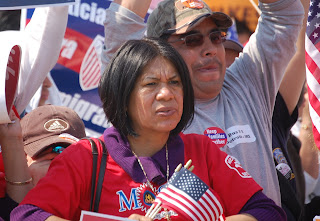
It was déjà vu – the sea of humanity chanting a message of hope and anticipation, pockets of people praying, dancing, singing. In another time and place the scene might have been called “People Power” but at the Mall last Sunday, it was America’s future staring the nation’s leaders in the face.
“March for America” organizers estimated the crowd at over 200,000 – the biggest pro-immigration rally in Washington DC.



In that crowd were Filipinos from all over the Metro DC region and from far away as New York and Chicago.
They are pushing for Congress to start working on bills, including one filed in the House of Representatives last December that provides for comprehensive immigration reforms.
As the third fastest growing Asian-American community in 2009, there’s a lot riding in the bills for Filipinos here as well as those in the Philippines.
“There are very few issues that specifically affect Filipinos in the United States and this is one of them,” explained Ben de Guzman of the Asian American and Pacific Islanders (AAPI).


HR 4321 – also known as the “Comprehensive Immigration Reform for America’s Security and Prosperity Act” -- authored by Chicago Congressman Luis Gutierrez (D, Illinois) and 92 other lawmakers, aims to mend growing gaps and defects in existing immigration laws.
A Senate version has been crafted by Democratic Senator Charles Schumer of New York and Republican Senator Lindsey Graham of South Carolina.
President Obama, in a videotaped statement shown during the rally, reaffirmed his commitment to “finally fix our broken immigration system”.
While the bills appear to address the main concerns of America’s Latino community (Obama won 66 percent of Latino votes in 2008), Fil-Am leaders say they will also have a profound impact on Filipinos in America.
Some have expressed reservations with the more restrictive Schumer-Graham proposal, but the House version contains provisions that target Filipino World War II veterans living in the US.
Sections 310 and 313 reflect the aspirations of the proposed Family Reunification Act that exempts Filipino veterans from immigrant visa quotas for children left behind in the Philippines.


Section 301 aims to eliminate the huge visa backlog. Next only to Mexican-Americans, Fil-Ams have the longest waiting time for petitions of relatives in the Philippines.
Family-based visa petitions for brothers and sisters, for instance, could take as long as 20 years.
More importantly, undocumented residents will be allowed to stay in the US (provided they have no criminal liability), work for their legalization after paying a fine, and eventually acquire citizenship.
There are an estimated one million Filipino “TNTs” (an acronym for “tago ng tago” meaning “hiding constantly”) who face arrest and deportation.
Coupled with toughening border security, the House bill will also reform the way illegal immigrants are arrested, detained and deported.


Some Filipino immigrants who’ve experienced this bewailed the practice of mixing potential deportees with hardened criminals in federal jails. Some alleged they were “treated like animals”.
And unclogging the visa gridlock could also pave the way for more Filipino professionals, particularly H-2 nurses, teachers and engineers, to land well-paying jobs in the US.


At the same time, lawyer Arnedo Valera of the Migrant Heritage Commission (MHC) explained, the proposed measure and other recent federal statutes expands protection to foreign workers against illegal recruiters or abusive employers.
“Undocumented immigrants are not a burden to America,” he stressed.
He explained their own studies show legalizing the estimated 12 million illegal immigrants will translate to a $1.3 trillion boost to the US Gross Domestic Product (GDP), making immigration reforms possibly the biggest yet cheapest stimulus bill.
“It’s been demonstrated that strict border enforcement alone will not solve the problem. What’s needed is to fix the broken immigration system and give the undocumented a way to come out of the shadows,” Valera averred.
The “March for America” was held just hours before the historic House vote to ratify the Senate’s healthcare reform measure.
Fil-Am community leaders say healthcare and immigration reforms are closely intertwined because both are crucial for the welfare of Filipinos in America.


“Just like healthcare reform, the time for immigration reforms is now,” Valera stressed.
But key immigration supporters on Capitol Hill worry if it won’t stir the same partisan passions as the healthcare reforms.
“It took us one year to pass healthcare reform. This may take a little time but we’re working on it,” assured Congressman Mike Honda (D, California).



“We are going to get the immigration reform bill passed this year. We’re going to make sure those issues like family reunification is part and parcel of the reforms. We have to work together to be part of this movement for immigration reforms,” he told ABS-CBN News.
Gicelle Fundales, the youthful president of the National Federation of Filipino-American Associations (NaFFAA) in the Metro DC region, said they will be mounting a campaign to call lawmakers, urging them to work on immigration reforms.

Honda explained the immigration reform bill should be viewed in the context of the larger national agenda to strengthen the economy and keep people secure and productive.
He said immigrants in the US send about $40 billion to their family and relatives in their countries of origin. By improving opportunities for reunification, Honda said much of that money will likely remain in the US.


A Pew Center report said that by 2050 White Americans will comprise just 47 percent of the population, compared to 85 percent in 1960. Hispanics are estimated to comprise 29 percent and there will be three times more Asian Americans during that period.
Fixing America’s broken immigration system is clearly another soul-wrenching debate that has to be made, simply because it’s a problem that simply won’t go away.

Given that the Filipinos are one of the top 3 immigrant population in the United States, the numbers didn't show it. It appeared like an overwhelming majority of latinos and a few scattered Filipinos here and there. The Asians in general represented very poorly at this march.
ReplyDelete